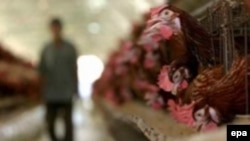London, 6 December 2005 (RFE/RL) -- The health experts gathering in London this week are quite open about the possibility of avian influenza becoming a global pandemic. Such a pandemic will come, they say, and the international community should be properly prepared.
"I think that most experts would agree that it’s not a matter of ‘if,’ but ‘when.' That includes most senior people within the U.K. -- [Britain’s Chief Medical Officer] Sir Liam Donaldson, for example. So I think we are all in agreement that it will happen at some time, but it’s been like trying to predict an earthquake," said Peter Openshaw, a specialist in experimental medicine at Imperial College in London and a delegate at the conference.
At the same time, he said, the disease is still rare, despite "billions of contacts" between birds and people every day. The number of confirmed cases of the deadliest strain of avian flu, H5N1, has reached only around 130 worldwide, with some 70 of those dying.
"I think if it mutates to a form that transmits between humans, then it will be almost impossible to prevent its worldwide spread. It’s very hard to imagine how that could be done. The most extreme measures that could be adopted -- for example, stopping all air flights, closing all schools, closing all places of work -- would only delay the spread," Openshaw said.
And he noted that, until the virus has actually mutated, "it's very difficult to actually go ahead now, press the button, and make that vaccine in large quantities."
Another problem is that no one knows whether the disease that has infected domestic birds in South Asia is being spread around the world by migratory birds. "There certainly is a migration from more easterly parts of Siberia down into Africa that goes through the most central and easterly parts of Europe," said James Kirkwood, a veterinary expert who specializes in the diseases of wild birds at the Universities Federation for Animal Welfare. "They fly south in the autumn and back up north in the spring. If birds took with them avian influenza, it could come back up the following spring. That’s one of the possibilities."
Kirkwood stressed, however, that this is only one of the existing hypotheses. "There is a school of thought that says that the cases that have occurred so far in the world may all have been associated, not with migrating birds, but with the transport -- legal or illegal -- of infected poultry," he said.
In October, Britain announced that finches from Taiwan being held in quarantine had died of the H5N1 strain.
Kirkwood said there has been a poultry vaccination ongoing in China, but that the question is what to vaccinate against. One vaccine that is available works against a mild strain. Another seemingly heals the birds, but they could continue being carriers of the disease and spread it further.
Colin Blakemore heads the U.K. Medical Research Council, the organizers of the conference. He said that with such uncertainties prevailing, the conference is coming at the right time. The conference aims to present a survey of current research activity around the world and to coordinate it in advance of any possible pandemic. It should wants to prepare a briefing paper for politicians and the general public.
Blakemore pointed out that the countries of Eastern Europe and Asia must play a crucial part in preparing for any such pandemic. There must be good plans in place for surveillance of the disease to give the rest of the world time to prepare the appropriate vaccine.
"This doesn’t necessarily mean that transmission to humans or the pandemic will happen in Eastern Europe or Central Asia," he said. "But it does mean that the subsequent flow of the disease is almost certainly likely to pass from its origins -- perhaps in China or Vietnam or in Thailand or Cambodia -- through Eastern Europe and Central Asia."
In Ukraine today, lawmakers voted to approve President Viktor Yushchenko's declaration of a state of emergency in three Crimean regions after more than 2,000 domestic poultry died of bird flu. Experts have yet to determine whether samples of the strain match the H5N1 virus.







